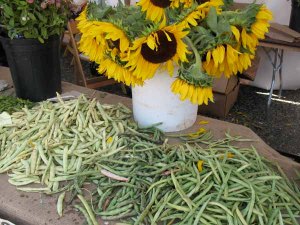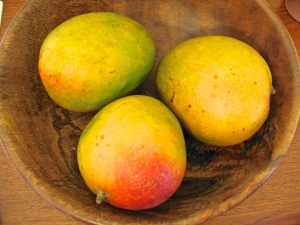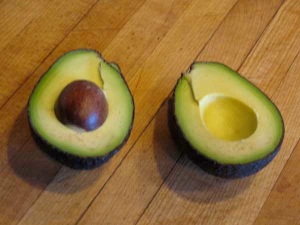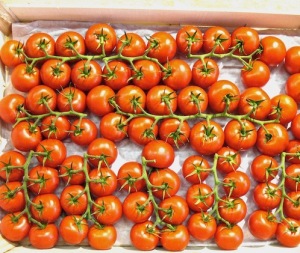I think about food a lot. In part because I seem to be incessantly hungry—the result, no doubt, of having to greatly curb my caloric intake now that I’ve reached what the French so delicately call un certain âge. But also because I’m pretty much obsessed with food, even when not hungry. I can’t tell you how many times I’ve begun discussing and planning a future meal before I’ve even finished the one still on the table. Doesn’t everyone do this?
Because, truly, let’s face it: Eating is the most important—and, I would argue, the most satisfying—human activity there is. So I think about the subject quite a bit, which is why my protagonist, Sally Solari, is also obsessed with food.
Recently, my food thoughts turned to the question, what exactly is the “official” difference between a vegetable and a fruit? You know the problem: A bell pepper is the fruiting part of the plant, is brightly colored, has seeds, and looks like a fruit. So why is it referred to as a vegetable?

A search on the web reveals numerous articles on the subject of “fruit vs. vegetable.” (See, e.g., here.) Certain plant foods are easy to classify: The non-seed-bearing parts—e.g., the leaves, stem, root—are almost (but see below) always vegetables, both in the botanical and culinary worlds.
The confusion arises with regard to the seed-bearing parts of plants. For instance, the flowers, if eaten before they produce seeds, are classified as vegetables. Thus, cauliflower and broccoli are vegetables, even though they would go to seed if left uncut.

There are, in fact, two different definitions for “fruit”: the scientific one, and the culinary one. In botany, a fruit is simply the seed-bearing part of any plant. Thus, green beans are fruit in scientific terms.

In culinary terms, however, a botanical fruit is only a “fruit” if it is sweet. The fabulous Harold McGee offers up this definition of culinary fruits in his wonderful treatise, On Food and Cooking:
Culinary fruits are distinguished from vegetables by one important characteristic: they’re among the few things we eat that we’re meant to eat. Many plants have engineered their fruits to appeal to the animal senses, so that animals will eat them and disperse the seeds within. These fruits are the natural world’s soft drinks and candies, flashily packaged in bright colors, and test-marketed through millions of years of natural selection.

They tend to have a higher sugar content, to satisfy the innate liking for sweetness shared by all animals. They have a pronounced and complex aroma, which may involve several hundred different chemicals, far more than any other natural ingredient.
And they soften themselves to an appealingly tender, moist consistency. By contrast, the plant foods that we treat as vegetables remain firm, have either a very mild flavor—green beans and potatoes—or else an excessively strong one—onions and cabbage—and therefore require the craft of the cook to make them palatable.
Sounds simple, non? But wait—there’s a hitch. Turns out that there are some seed-bearing parts of plants that are not sweet, but which are nevertheless often classified as fruits in the culinary world. The avocado, for example, is considered a fruit by many cooks. (See, e.g. here.) Perhaps this is because it is sometimes used in desserts, such as avocado pie.

And that’s not all. There are non-seed-bearing plant parts that are considered fruits by many cooks, such as rhubarb (see, e.g., here). This is no doubt because, although it isn’t sweet, rhubarb is used as a fruit in making desserts.
And then sometimes it takes the U.S. Supreme Court to decide whether the plant part is a fruit or vegetable. (Yep, I’m an ex-lawyer, as is Sally Solari.) In Nix v. Hedden (1893), the court observed that tomatoes are “usually served at a dinner in, with, or after the soup, fish, or meat, which constitute the principal part of the repast, and not, like fruits, generally as dessert.”

Thus, the court determined, the tomato was a vegetable, and subject to the Tariff Act.
Readers: So, how do you cooks and non-cooks out there define fruits and vegetables? I’d love for you to share any amusing stories you might have on this conundrum!

I would generally agree that if it’s sweet, it’s a fruit. Also, I had no idea the fruit-vs.-vegetable debate once went all the way to the Supreme Court. I find that oddly amusing.
LikeLiked by 5 people
Floored me, too, Marla!
LikeLiked by 4 people
The ex-lawyer in me LOVED that the issue went up to the US Supreme Court, lol.
LikeLiked by 4 people
That IS interesting and (I agree, Marla) amusing, wow.
LikeLiked by 2 people
Leslie, I am also food-obsessed, and like you, I am thinking about planning the next meal as I am eating one. And lately, the challenge has been to find the ingredients on my grocery list without having to go to multiple sources (online or in person)!
I always knew that tomatoes are fruits and not vegetables but that definition of seed-producing plants is a new one for me. So I looked online, and along with the ones you mentioned above, so other plants were listed as fruits that I was not expecting: corn, olives, okra!
LikeLiked by 5 people
Okra’s a fruit! Yay! Perhaps we need to come up with an okra ice cream or pie…
LikeLiked by 2 people
Great post, Leslie! So basically, now that you’ve explained this extremely well (and I learned a lot), I see that I enjoy, and generally subsist on, fruit. With all your great recipes, though, I *might* eat veggies (esp. if you cooked them for me!).
LikeLiked by 4 people
My trick for making veggie haters love veggies is to cook them with LOTS of butter–and often garlic, as well.
LikeLiked by 3 people
Basically if it comes off a tree I call it a fruit If it goes into a salad I call it a vegetable. I try to keep things simple. I’m well past 60 and need to deal with things in a simple way. I ask what she wants for dinner and she ways “what do you want?” So it all hangs in the air till we’re hungry and I throw something together. LOL
LikeLiked by 4 people
Ha! Love this, Nora!
LikeLiked by 3 people
Knowledge is knowing a tomato is a vegetable. Wisdom is not putting it in a fruit salad.
Which begs the question – is ketchup a smoothie?
You probably aren’t aware of it, but there is a very popular Christian children’s series called VeggieTales. The hosts of the program? Bob the Tomato and Larry the Cucumber, which means both of them are really fruit.
LikeLiked by 5 people
Love that saying, Mark! (I may steal it.)
Ketchup (or catsup) is actually a kind of Indian chutney, that we Yanks have adopted as our national vegetable–or smoothie.
And no, I didn’t know about the VeggieTales, but sounds fun! Perhaps they need to make an episode with explores their realization that they’re really fruit, lol. A good fable about how life is always nuanced…
LikeLike
Okay, how come I didn’t know about avocado pie before? Also, I CANNOT think of green beans as fruits, no matter how hard I try, but I’ll happily accept rhubarb because of the pie.
But, wait, isn’t there tomato pie? Or did I dream that?
Weird how all of my focus went right to the pie part…and now I’m craving pie.
Great post, Leslie!
LikeLiked by 3 people
And then there’s pork pie… I am so hungry now.
LikeLiked by 1 person
Leave it to the court to rule tomatoes are a vegetable — for tax purposes, lol! I’d argue that when tomatoes are perfectly ripe, they are a little sweet! Great post, Leslie!
LikeLiked by 2 people
It’s true! Hmmm… Maybe I’ll make a tomato tart with sugar this summer, once my heirlooms are ripe.
LikeLiked by 1 person
Fabulous post, Leslie! I learned so much. My daughter has been talking about making an avocado pie!
LikeLiked by 2 people
They’re pretty darn scrumptious!
LikeLiked by 2 people
I can’t wait to taste the fruits(!!) of her labor.
LikeLiked by 1 person
“These fruits are the natural world’s soft drinks and candies, flashily packaged in bright colors, and test-marketed through millions of years of natural selection.” I love this! You should be a writer.
For me, fruit is what I eat at lunch, and vegetables at dinner. Anything in between is ice cream.
LikeLiked by 2 people
OMG, this was fascinating! Jer and I debate this very issue sometimes. And now I can tell him, hah! Supreme Court says tomato’s a vegetable, so there!
As to the thinking about your next meal while you’re eating a meal, Jer’s been laughing about how my family does that ever since we met. It’s an ethnic thing, I think, with my Italian mother and Jewish father.
I have one question for you – with all this food obsession, how do you stay so dang slim???
LikeLiked by 2 people
I eat very little during the day, and go on long bike rides and walks. But it is a struggle…
LikeLiked by 1 person
And ice cream can be both a fruit and a vegetable.
LikeLiked by 1 person
We recently had a household discussion about avocados. Fruit or not?
The Supreme Court ruling is an eye-opener, though. All this time I’ve been telling the kids that tomatoes are fruits!
LikeLiked by 1 person
And now you’re vindicated, Jen!
LikeLike
Thank you so much for this informative post. I too might try the avocado pie.
LikeLike